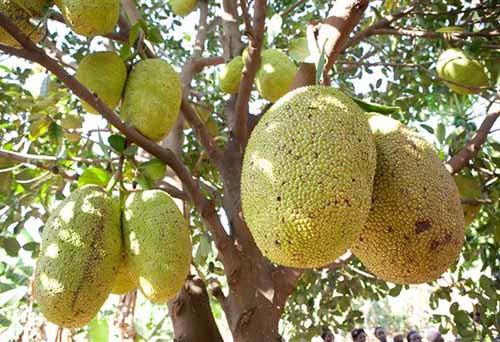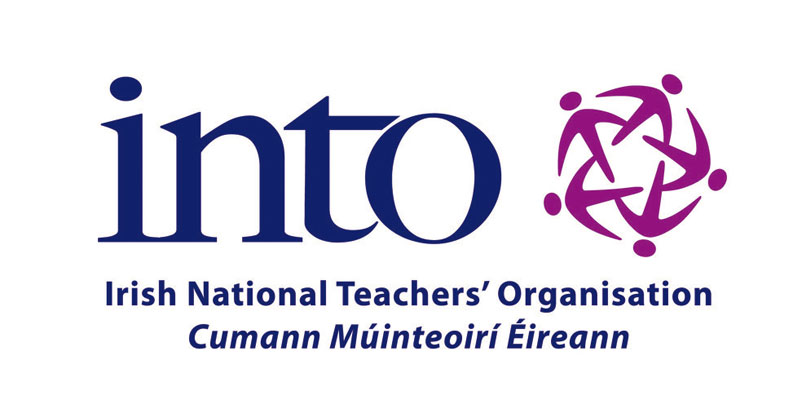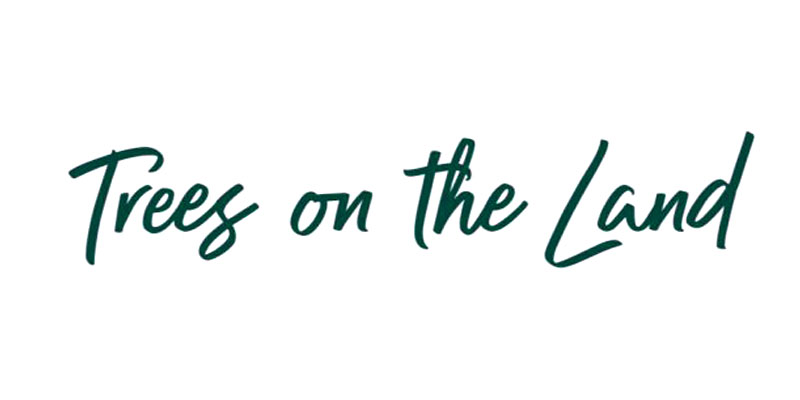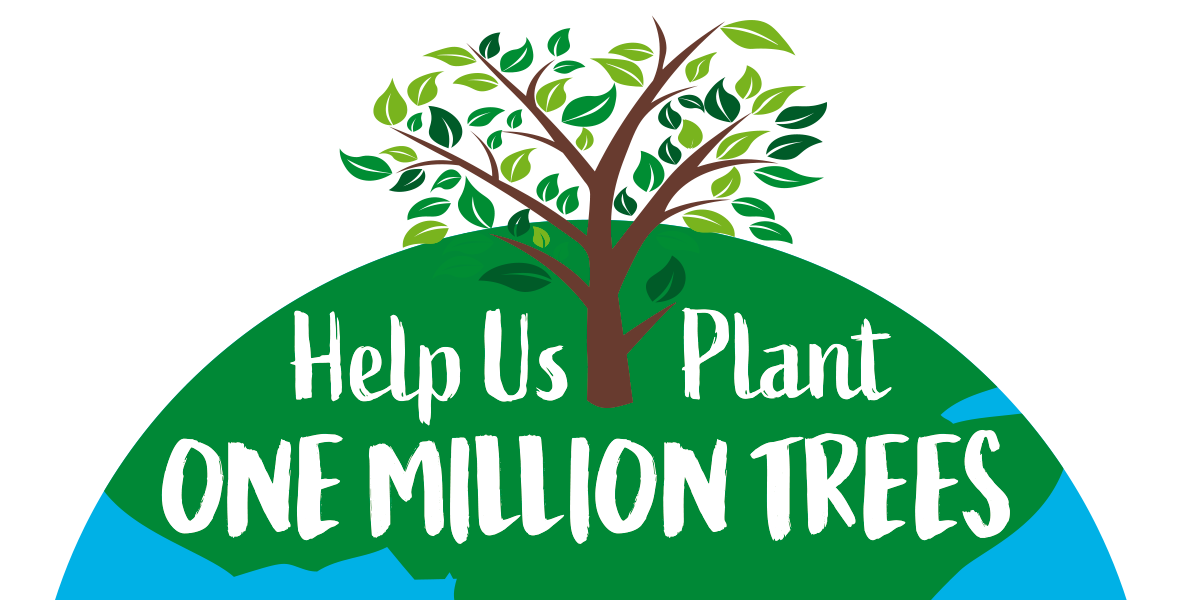
Tree Directory
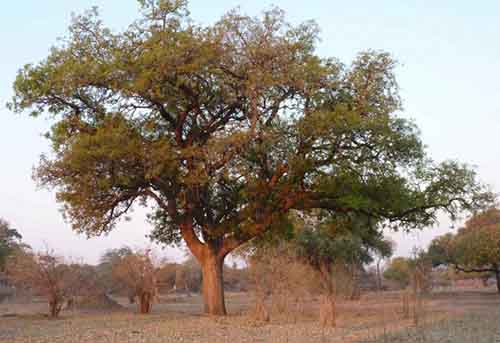
Faidherbia Albida
Self Help Africa planting in Malawi, Zambia, Ethiopia and Burkina Faso.
Faidherbia is the ideal tree to intercrop with cereal crops like maize, sorghum, and millet. In Zambia for example, maize yields were 3 tonnes per hectare under Faidherbia canopies and only 2 tonnes per ha. outside the canopies.
This tree has a unique “Reverse phrenology”, meaning it produces leaves in the dry season and sheds leaves in the rainy season. Also, the tree is able to take nitrogen, an essential fertiliser, out of the atmosphere through bacteria that grows on its roots.
Where this tree grows spontaneously, farmers protect the seedlings that naturally emerge. This is a system promoted by Self Help Africa in all projects – known as Farmer Managed Natural Regeneration (FMNR), where farmers are trained and supported in managing their resources to maintain and improve their land, farms and livelihoods.
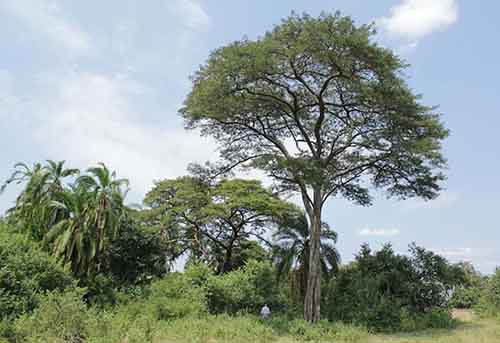
Acacia polyacantha
Self Help Africa planting in Malawi
The variety of Acacia is very important to to the farming communities Self Help Africa works with in Malawi. The trees are primarily used for conservation of catchments - areas where the rainwater collects and usually drains off into a waterbody (like a river, pond or lake). Planting trees in these catchment areas will help to improve the supply of water that will be used for domestic and agricultural needs.
Forested catchments will also help to reduce soil erosion and to buffer watercourses from pollution; to stabilise river banks, reducing bank erosion; and planting trees can help reduce flooding, and slow down flood water during flood events.

Gliricidia
Self Help Africa planting in Malawi
Gliricidia is a fast growing tree common to southern and eastern Africa. The trees are planted for 'intercropping'; to provide fodder, and improve soil fertility.
When intercropped with maize, Gliricidia is cut back in the growing season to prevent competition with the maize crop for water, light and nutrients, and the cut leaves are used as mulch - to fertilize the soil.
Once the maize has been harvested Gliricidia is allowed to re-grow to provide vital fodder for livestock during the dry season.

Neem (Azadirachta indica)
Self Help Africa planting in Ethiopia and Burkina Faso
Neem is a fast-growing and long-lived evergreen tree that can grow to 15 metres tall with a wide-spreading, dense, crown that provides year-round cool shade in even the hottest places.
A true multipurpose tree, neem is a very valuable plant to grow. It is a very effective medicinal herb for treating fevers, provides food, a very good insecticide and insect repellent (sleeping under a neem tree keeps away mosquitoes and neem headlice treatment is sold in Ireland!). In Africa, farmers also use neem leaves in grain stores keep away insects, and in the hot and dry countries of the Sahel, Neem is often planted along streets to provide shade.
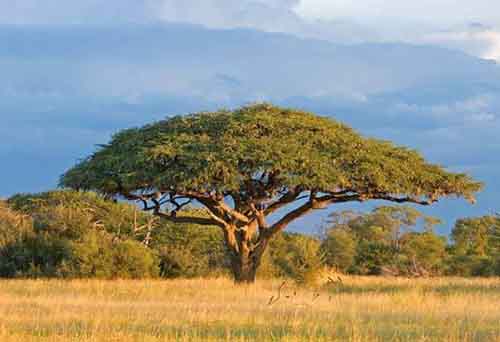
Gum Arabic (Acacia senegal)
Self Help Africa planting in Ethiopia and Burkina Faso
This may not be a species you're familiar with but it's in food and products you use every day. The tree produces Gum Arabic - a stabilizer used in everyday foods and in a very well known Irish beverage - it helps make the creamy head on a pint of Guinness!
In Africa - the Acacia Senegal grows in semi-arid areas, in countries like Burkina Faso and Ethiopia, where other agriculture can be quite fragile. Sap collection (the 'gum'), provides employment and income for farmers, but more than that the leaves and fruit give fodder for sheep and goats; and the roots help fix nitrogen in the soil.
Self Help Africa has also established several beekeeping projects in the communities where the Acacias grow, and the tree flowers provide nectar for those bees! This results in delicious nutritious honey that families eat at home and sell to earn extra income.
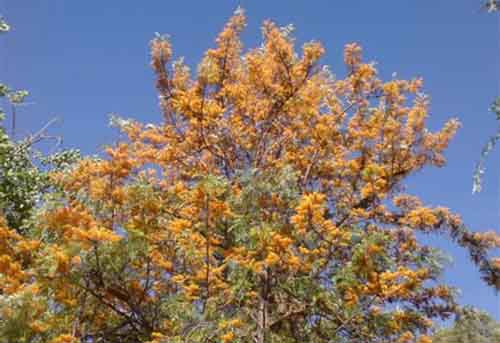
Silky oak (Grevillea robusta)
Self Help Africa planting in Kenya and Uganda
Also known as 'griveria' locally, the Silky Oak is an erect, single-stemmed tree typically reaching 20-30 m tall and 80 cm in diameter. Grevillea is one of the most important trees to grow, and be planted in the tropical highlands of East and Central Africa.
It is commonly planted as a boundary tree around the perimeter of small farms, in a single row at 2-2.5 m spacing. It is also planted in rows between small fields, and as scattered individuals over crops such as coffee and maize.
This tree is also planted in rows along the contour to conserve soil on sloping lands in the tropical highlands. There is also some evidence to show that using the leaves as a mulch can reduce soil losses on sloping land.
For the farmers Self Help Africa works with in these upland regions – being able to protect and nourish the soil is vital to improve farm yields and income.
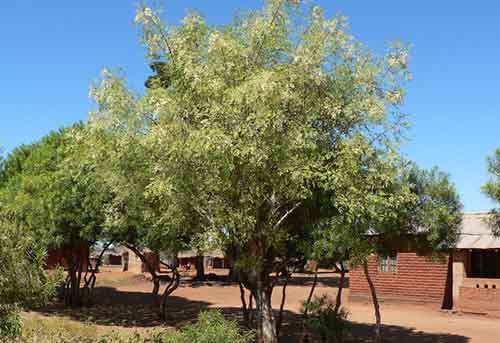
Moringa, drumstick tree (Moringa oliefera)
Self Help Africa planting in Ethiopia, Zambia, Uganda, Malawi, Kenya
Although native to Asia, Moringa is widely grown in Africa, where its leaves are used for spinach, the pods are cooked like green beans and the seeds from more mature pods are cooked like peas or roasted like nuts.
Moringa grows quickly and is drought resistant. The dried leaves retain lots of vitamins and minerals.
The farmers Self Help Africa works with in East and Southern Africa are encouraged and trained in growing moringa as a way to improve child and maternal nutrition.
Oil from moringa seeds is used in foods, perfume, and hair care products, and as a machine lubricant. The seed cake remaining after oil extraction is used as a fertilizer and both the seeds and the seed cake have the unique ability to purify water.
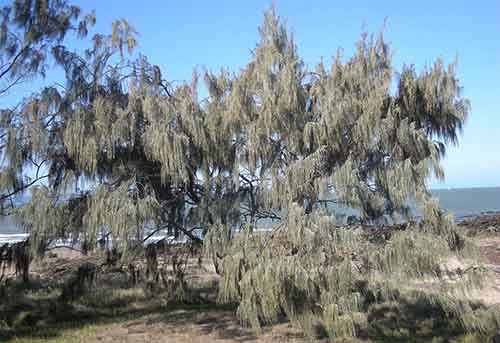
Casuarina equistifolia, (also known as beech she-oak, common ironwood)
Self Help Africa planting in Kenya
Casuarina is a remarkable evergreen tree with a finely branched, feathery crown. Unlike most trees Casuarina is salt tolerant and grows well in sand, so it can be used to control erosion along coastlines, estuaries, riverbanks and waterways and to stabilise sand dunes.
It is often planted for reclaiming and improving the land. The abundance of highly branch twigs absorb wind energy amazingly well, and in areas with hot, dry winds the tree protects crops and animal herds.
Casuarina fixes atmospheric nitrogen through symbiosis with a root fungi. Because of this partnership Casuarina is able to grow vigorously on barren, polluted sites and thrive in deep sandy soils.
Casuarina is idea for planting on field boundaries in arid and semi-arid areas as it does not shade the crop very much, adds nitrogen to the soil and yields substantial quantities of green leaf manure on lopping. SHA is planting casuarina in sandy areas in Kenya, especially along the coast.
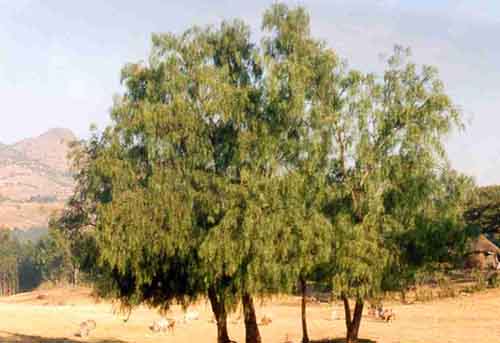
Peruvian pepper tree (Schinus mole)
Self Help Africa planting in Ethiopia
The Peruvian Peppertree is a fast growing, elegant evergreen tree with a wide crown of weeping foliage between 6 to 15 metres tall. It produces flowers from April to June and is one of the few trees that will contain male only or female only flowers, where separate male and female plants must be grown if further seed is required.
The Peppertree is used for food - its lush red berries produced can be dried and roasted and used as a pepper substitute. On a larger scale, the fruit can be distilled to create an oil which is used in spiced baked goods, chewing gum and sweets
Farmers working with Self Help Africa plant the Peruvian Pepper tree to restore degraded land areas in Ethiopia.
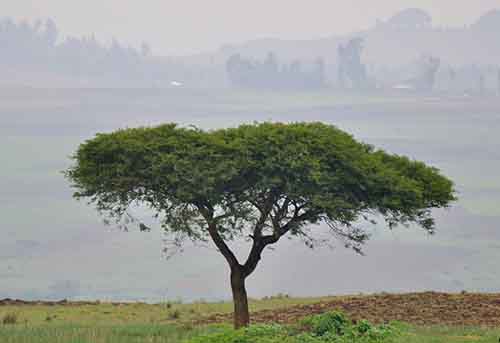
Umbrella thorn (Acacia abyssinica)
Self Help Africa planting in Ethiopia
Familiar to everyone from David Attenborough’s documentaries and films like “The Lion King” and “Out of Africa”, probably no other tree symbolises the African savannas as much as flat topped Umbrella Thorn.
Found in Africa from Ethiopia to Mozambique and Zimbabwe the Umbrella Thorn is drought tolerant, produces its own nitrogen and will grow on degraded land and along gullies, making it a good species for restoring degraded land. The Umbrella Thorn provides an edible gum, medicine, fodder and shade for livestock and the well-known acacia honey. The Umbrella Thorn is one of the species that SHA plants to help restore degraded land areas in Ethiopia.
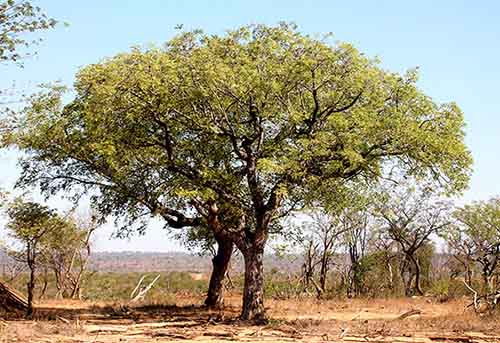
Marula (Sclerocarya birrea)
Self Help Africa planting in Malawi and Zambia
Marula is a medium-sized deciduous tree, indigenous to Southern Africa, the parklands of the Sahel and Sudan, and Madagascar.
Collecting the fruit of wild marula tree is an important source of income for women in rural communities. The fruit is eaten at home, and sold at market; and the juice and pulp are mixed with water and fermented to make traditional marula beer. There are local tales of elephants becoming drunk on the fallen and fermented fruits!
Commercially the frozen fruit puree is used in juice blends and marula oil is used as an ingredient in cosmetics as a skin moisturizer and as an edible oil in Southern Africa.
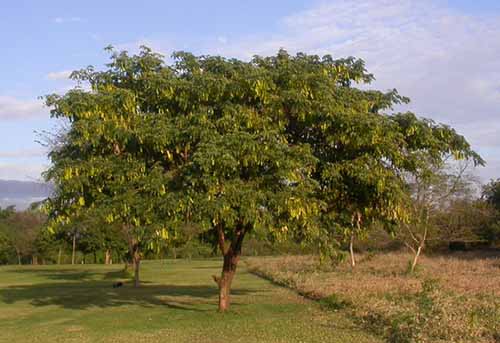
Albizia lebbeck
Self Help Africa planting in Malawi
Albizia lebbeck has been commonly called the ‘Woman’s Tongue Tree’ or the ‘Shak Shak tree’. These names come from the rattling sound the seeds make inside the pods when it is windy. These seeds are edible and can be harvested when the pods turn yellow. They are dried in the baking sun before they go brittle and can be beaten with a flail to be extracted and combined in a meal.
This tree can grow to 30m in height and produces large white flowers which are very fragrant and delicate looking.
Self Help Africa plants Albezia for shading crops like coffee and banana, for shelterbelts and for providing nitrogen to crops. Albezia also provides fodder for small livestock.
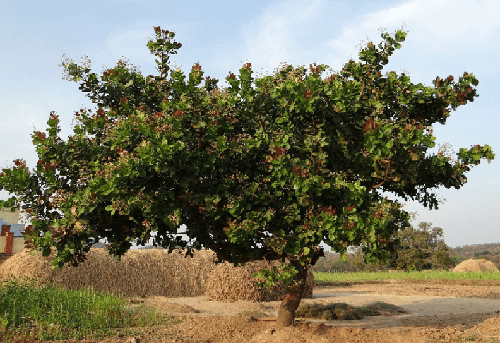
Cashew (Anacardium occidentale)
Self Help Africa planting in Kenya, Zambia and Burkina Faso
Familiar to everyone, the cashew is a tropical evergreen tree that can grow up to 14 metres, and the smaller dwarf species reaching 6 metres. There are over 600 species in the Anacardium family, including mango, pistachio) but the cashew is by far the most economically important.
The Cashew tree is mainly grown in the wet and dry tropics where it can withstand temperatures of above 40 degrees Celsius. They are excellent trees for warmer regions and are pretty much drought resistant. SHA is promoting the planting of new cashew orchards, and the rehabilitation of old orchards in Kenya, Zambia and Burkina Faso. New orchards and old trees are being replaced with dwarf varieties as these can produce economic yields after 3 years as compared to waiting 8 years for the traditional species.
To improve both soil fertility and household nutrition SHA has developed a system of planting beans between the cashew trees.
The cashew nut is very unusual as it hangs underneath the cashew apple, rather than being hidden inside the fruit. The cashew apple matures in 90 days, can be eaten fresh, is high in Vitamin C and has a refreshing, sweet taste. Cashew apples are also used to make the alcoholic drink ‘Feni’.
The cashew nut is high in protein and is eaten across the world. Export demand is high and cashew nuts are a very export valuable crop.
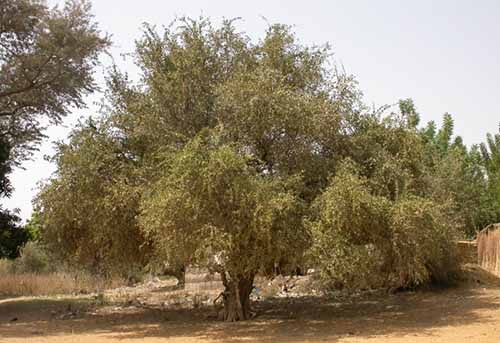
Desert date (Balanites aegyptiaca)
Self Help Africa Planting in Burkina Faso
Balanites aegyptiaca is found across the Sahel-Savannah region of Africa. Balanites is valuable in arid regions because it produces fruit even in dry times. The yellow, single-seeded fruit is edible but bitter. Some trees have unusually sweet fruit and these can be grafted onto the roots of bitter trees.
The fruit can mixed into porridge and eaten by nursing mothers; and is sometimes fermented for alcoholic drinks. Other parts of the tree are used as food during the ‘hunger gap’. The leaves are eaten raw or cooked, the oily seed is boiled to make it less bitter and eaten mixed with sorghum, and even the flowers can be eaten.
Another important use for the Desert Date is the control of the parasites Bilharzia and Guinea worm. These parasites are spread by water snails and copepods. Bilharzia is particularly widespread in the tropics wherever people are in contact with lakes and wetlands: farmers irrigating their crops, fisherfolk, children playing. The bark and fruits of the Desert Date repel and kill the snails and copepods and Balanites is often planted on the border of irrigation canals and rivers so that the fallen fruits control the bilharzia carrying snails.
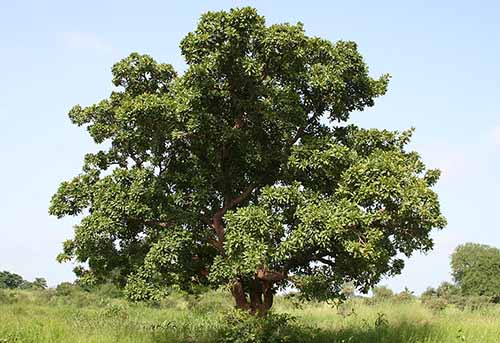
Shea nut (Vitellaria paradoxa)
Self Help Africa planting in Malawi and Zambia
The Shea Nut Tree is an important part of the economies of the countries of the Sahel, and is Burkina Faso’s third most important export, after cotton and livestock.
In West Africa, shea nut cultivation is particularly important for women, as they control the shea nut butter value chain. Self Help Africa works with women farmers in Burkina Faso to plant and protect shea nut trees, helping women maintain and earn an independent income, even in the drier seasons.
The tree starts producing nuts when it is 10 to 15 years old and can produce nuts for up to 200 years. The fruits resemble large plums and an average tree can produce 15 to 20 kilograms of fresh fruit per season.
An edible oil is extracted from the nuts that has the texture of butter at room temperature. Shea Nut butter is used for cooking, and as an ingredient in chocolate. But it's also well known for its use in cosmetics, for example skin moisturizers, hair conditioners, lipsticks and lip gloss.
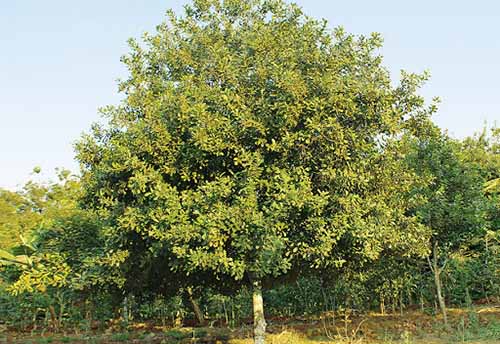
Macadamia
Self Help Africa planting in Malawi, Kenya, Uganda
Macadamia is an evergreen tree that grows up to 12 metres in height. The genus is comprised of 4 species but all produce the same fruit, which is more commonly known as the macadamia nut. The tree takes between 5 and 8 years before producing its first fruit. Once the nuts are ripe they fall from the tree and can be easily picked from the ground. Even with this easy harvest, only a few nuts get produced on each tree each year which makes macadamias most expensive nut in the world!
Malawi and Kenya have established macadamia industries, and Uganda is catching up.
Macadamias produce an oil which can be as high as 80% fat content. This oil is commonly used in cooking and cosmetics.
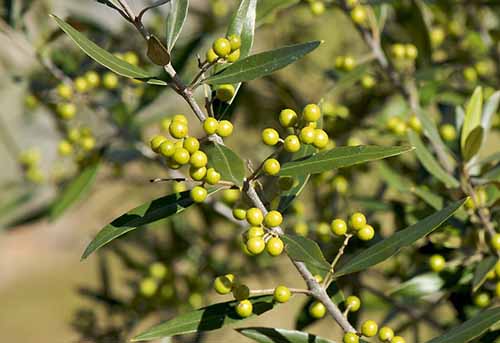
African Olive (Olea europaea subsp. africana))
Self Help Africa planting in Ethiopia
The African Olive is a subspecies of the European Olive. Is a neatly shaped evergreen tree with a dense spreading crown (9 x 12 m) of glossy grey-green to dark-green foliage. It has strong smelling white flowers from July to March, which is quickly followed by a glossy fruit that ripens from green to red to black.
The olives are usually made into a non-drying oil which is used on salads and in cooking. And the fruits are also a popular food amongst native wild animals, such as monkeys, baboons, mongooses, bushpigs, warthogs, bats and birds.
The African Olive tree is an asset on farms in very dry areas because it is extremely hardy and is an excellent fodder tree for livestock. Unfortunately, the African Olive is becoming endangered, so Self Help Africa plantings will act as a conservation measure for this traditional species.
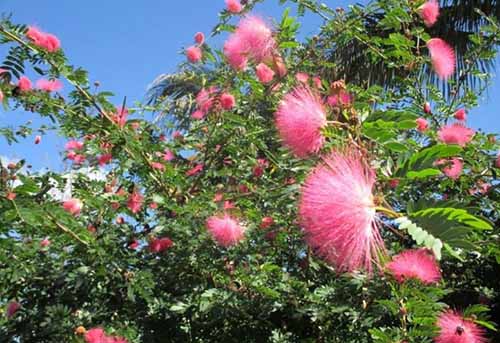
Calliandra calothyrsus
Self Help Africa planting in Uganda
As known by locals as “Powderpuff”, Calliandra is a small, fast growing shrub that produces flowers that look like umbrella clusters. Calliandra produces a beautiful pink coloured flower during the dry seasons of June to September. This colour attracts lots of bees and the honey made from Calliandra calothyrsus has a very unique sweet taste. Calliandra is one of the favourite flowers of sunbirds, the stunning African ecological equivalent to the American Hummingbirds.
Calliandra produces its own nitrogen, and grows in many areas, including less fertile soils, which makes it a brilliant addition to the African landscape. Self Help Africa is planting Calliandra calothyrsus for the rehabilitation of erosion prone areas in Uganda and to provide nitrogen for crops. Calliandra is commonly planted in small villages as strips of hedgerow, this protects against fire and illegal wood cutting.
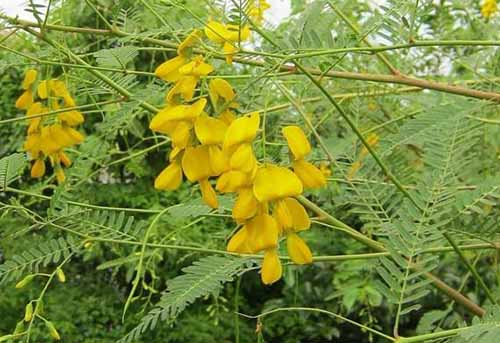
Sesbania sesban
Self Help Africa planting in Kenya and Uganda
Riverhemp is the common name for plants in the Sesbania family. Sesbania is a small, but fast growing tree that grows to about 5 metres in height after only 6 months!
Sesbania produces its own nitrogen and Self Help Africa encourages farmers to grow this tree as an ‘intercrop’ with maize, bean and cotton in Kenya and Uganda to reduce the need for farmers to buy nitrogen fertilisers.
The yellow flowers are used for decorative purposes and can also be eaten as a vegetable. The fresh seeds are poisonous to humans but they can be eaten if they are soaked for 3 days and then cooked. They can also be ground into a fermented paste known as ‘Soumbara’.
Locally, the leaves are used to treat scorpion stings, boils and abscesses where they are considered to have antibiotic properties. The seeds can also be made into an antibacterial medicinal oil which is widely used amongst small communities.
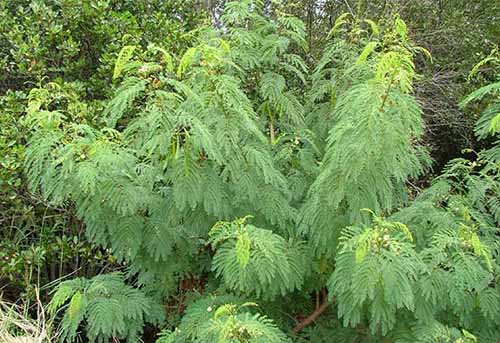
Leuceana leucophala (White Lead Tree)
Self Help Africa planting in Malawi
Self Help Africa Planting in Ethiopia, Kenya, Malawi, Zambia, Uganda
Leucaena leucocephala, or more commonly known as ‘White lead tree’, is a fast-growing evergreen tree that can grow up to 20 metres tall, produces its own nitrogen and can be repeatedly cut back. Leucaena is widely cultivated for shade, animal feed, firewood and soil fertility.
The young pods are edible and are high in protein. They can be used for cooking, where they are commonly found in spicy dishes.
Self Help Africa is working with farmers to plant Leucaena in their fields to stabilise the soil, fertilise the crops and feed small livestock such as goats.
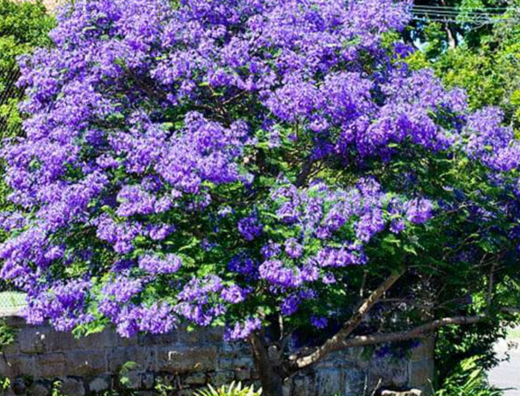
Jacaranda mimosifolia
Self Help Africa planting in Kenya, Uganda, Malawi, Zambia.
Jacaranda mimosifolia (jacaranda, blue jacaranda, fern tree) is a deciduous tree up to 20 m in height with spreading branches making a light crown. Bark pale brown and furrowed, transverse cracks dividing the ridges between the furrows into long, narrow scales. The bole almost always short and malformed, and up to 40- 50 cm in diameter.
Trees are being planted in in forested areas, agroforestry systems, plantations, boundaries, homesteads
This species’ relatively large flowers easily attract bees; therefore, it is suitable for bee forage. Extracts from its leaves, bark, and roots have medicinal value. The tree creates pleasant open shade and can be used effectively as a screen or as a windbreak. The finely cut foliage is attractive adding to its flowers’ ornamental value.
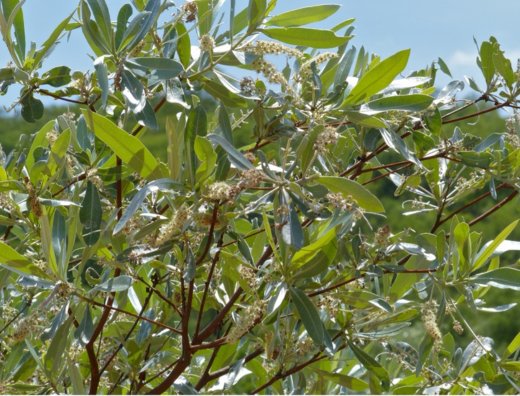
Terminalia sericea
Self Help Africa planting in Malawi, Zambia, Mozambique
Also known as ‘Mpululu’ Terminalia sericea (silver terminalia) is a small, well-formed deciduous tree, 3-16 m with spreading branches to a light rather flat crown. It’s bark dark grey or grey brown, rather rough with longitudinal fissures; branchlets with characteristic purplish bark peeling off in strips, pale below; simple leaves clustered towards the tips of branchlets, 5-12 cm long, narrowed to the base, pale green, leathery, with silvery silky hairs below. Young leaves pink and dying leaves deep pink before they fall; flowers are cream to pale yellow, in short spikes to 5 cm; buds are silky hairy, opening with new leaves; and fruits pink purple-brown, to 4 cm long, oval and flat, winged around the central seed, tip notched.
The tree occurs in Brachystegia woodland and wooded grasslands, especially on sandy soils, between 450-1,300 m. It can be propagated using seedlings or root suckers Uses include medicine from leaves and roots, bee forage (flowers), rope from bark , red dye also from the bark.
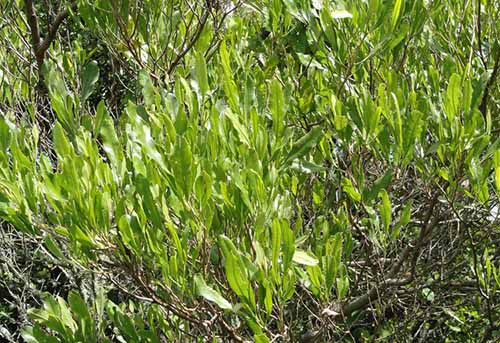
Dodonaea viscosa
Self Help Africa Planting in Ethiopia
Dodonaea viscosa var. angustifolia (hopbush) is a fast growing drought and wind resistant indigenous evergreen which grows up to 5 m high. Dodonaea prefers a sandy substrate and requires little water once established. The roots bind the soil and Self Help Africa is working with communities in Ethiopia planting Dodonaea to stabilize sand dunes and control soil erosion in the Lake Ziway region.
The tree forms a dense bush which is ideal for bird nesting sites and the flowers attract butterflies. The seed has papery wings and is dispersed by wind.
In Africa the plant is often used in traditional medicine to treat common complaints like fever, colds, sore throats, coughs and the leaves can be used as wound dressings.
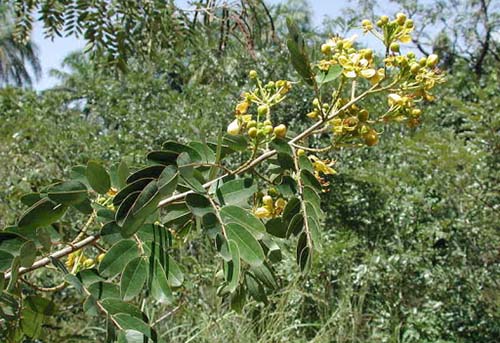
Siamese senna (Senna siamea)
Self Help Africa Planting in Malawi
Siamese Senna is a medium-size, evergreen tree with distinctive yellow flowers. The tree is regularly grown as a ‘shade’ tree for other crops such as coffee.
The tree is regularly cut back to provide much needed fodder, mulch for fertilizing land to grow other crops, and the cut back branches offer a supply of firewood.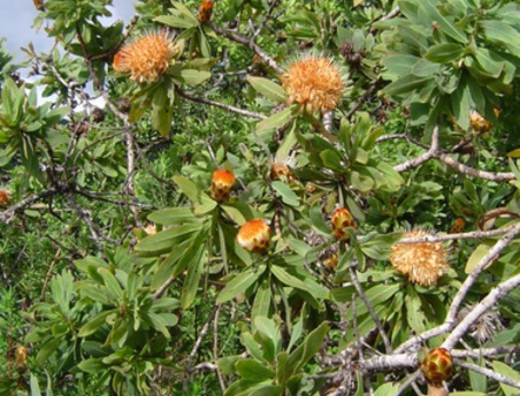
Protea Welwitschia
Self Help Africa planting in Uganda, Malawi, Mozambique, Zambia.
Protea welwitschia (cluster-head sugar brush, dwarf savanna sugar brush) grows as a spreading, multi-stemmed shrub or small, gnarled, bushy tree. In tropical East Africa and Zambia it grows to 1–3 metres, exceptionally 5 metres in height. In its shrub form it may have an underground bole or rootstock, from which the branches arise. The trunk grows to 30 centimetres in diameter at the base. It is gnarled, and covered in an irregularly fissured, brown-black bark. The young stems are covered in a brown woolly hairs.
The adult plant can survive the periodic wildfires that burn through its habitat by re-sprouting from the underground bole and hence considered among landscape conservation tree species. It also acts as a windbreak, used for its ornamental value, and its flowers are good bee forage.
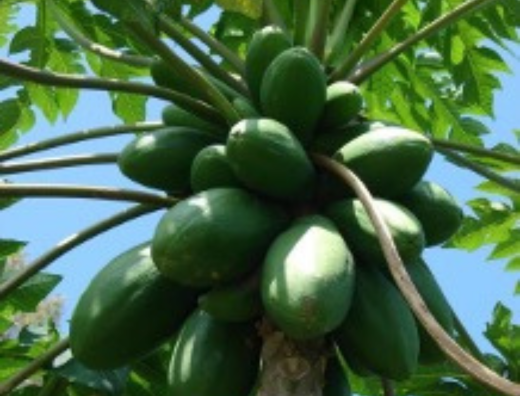
Carica Papaya
Self Help Africa planting on-farm in most countries as a food source
Carica papaya (pawpaw, papaya) is a is an evergreen, tree-like herb, 2-10 m tall, usually unbranched, although sometimes branched due to injury, containing white latex in all parts. Stem cylindrical, 10-30 cm in diameter, hollow with prominent leaf scars and spongy-fibrous tissue. Has an extensive rooting system.
Green papaya fruit is cooked as a vegetable. Ripe papaya fruit is a breakfast and dessert fruit that can used to make fruit salads, refreshing drinks, jam, jelly, marmalade, candies, and crystallized fruit. Young leaves are sometimes eaten. Other uses: Papain, a proteolytic enzyme present in the latex from green fruit is extracted to be used in beverage, food and pharmaceutical industries. It is also used in bathing hides, degumming silk and softening wool. Carapine, an alkaloid present in papaya, has medicinal value. The fruit and juice are eaten for gastrointestinal ailments; a fresh leaf cataplasm is used to treat sores.
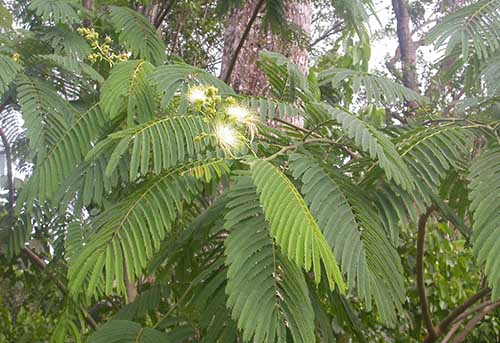
Albizia chinensis
Self Help Africa Planting in Kenya
Albizia chinensis is, as the name indicates, native to south and southeast Asia, It is grown as a shade tree for coffee and the leaves and pods are excellent fodder for goats.
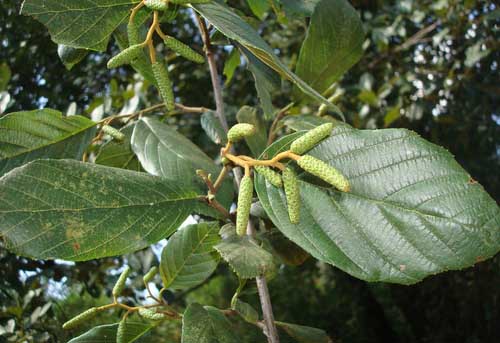
Mexican Alder (Alnus acuminata)
Self Help Africa Planting in Kenya
This is a species of Alder from the mountains for Mexico and South America. The timber is light to reddish-brown and fine grained and is used for building bridges, coffins, furniture and plywood. Alders put nitrogen from the atmosphere into the soil through their roots, but this done though a symbiotic relationship with a fungi, unlike Leguminous species that fix nitrogen through root bacteria.
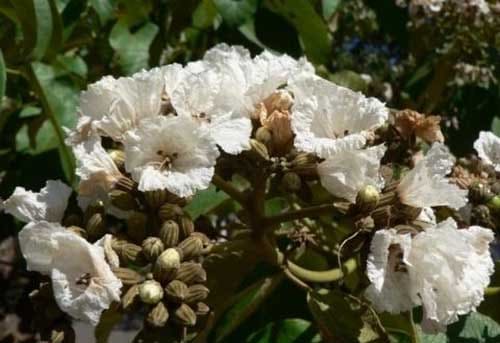
Sudan Teak (Cordia africana)
Self Help Africa Planting in Kenya
Sudan Teak is a small to medium-sized evergreen tree, 4-15m high, heavily branched with a spreading, umbrella-shaped or rounded crown. The trunk is often curved or crooked.
The heartwood is pinkish- brown, reasonably durable and relatively termite resistant which it works easily and polishes well but is often twisted and difficult to saw. The timber is used for flooring, high-quality furniture and beehives. The fruit is edible, the leaves can be used for animal forage and Cordia is often planted as a shade tree in coffee plantations.
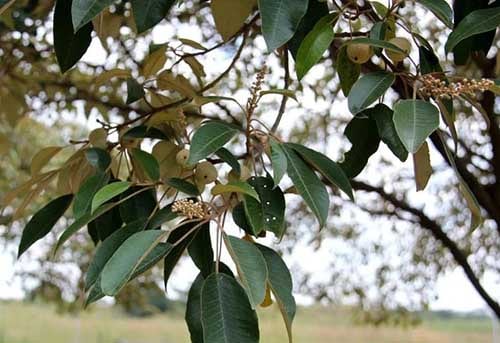
Croton (Croton megalocarpus)
Self Help Africa Planting in Kenya
Croton is in the family Euphorbiaceae, a family of plants that produce white latex. It is fast-growing tree, growing up to 36 meters high and reaches maturity after five to seven years. Croton is commonly found in natural forests and is planted on farms as a boundary tree. It is a drought-resistant tree that can survive in harsh climatic conditions and is not browsed by animals.
Croton produced large quantities of inedible nuts that can be used to make biofuels. Compared to diesel, Croton oil is self-lubricating and has a higher flash point, making it safer with lower exhaust emissions. The seed cake can be used as animal feed and compost. Croton is indigenous to ten countries in Sub-Saharan Africa, including Somalia, Kenya, Uganda, Democratic Republic of the Congo, Rwanda, Burundi, Tanzania, Malawi, Zambia, and Mozambique.
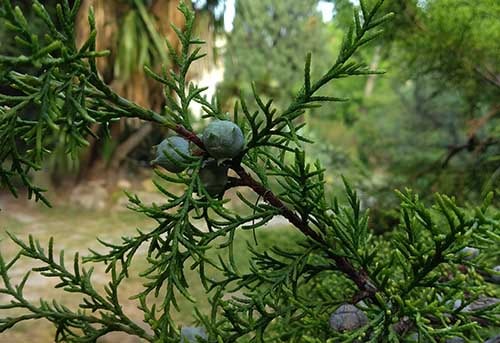
Cupressus lusitanica (white cedar)
Self Help Africa Planting in Kenya
Cypress is an evergreen tree, native to Mexico and Central America, which grows to a height of about 40 m and 70cm diameter and related to the popular hedge species the Leyland Cypress. Cypress is a popular softwood species for timber, building poles and paper pulp in Africa but attacks by the cypress aphid, Cinara cupressi, can kill the trees. Cypress can be intercropped with other plants while they’re still young.
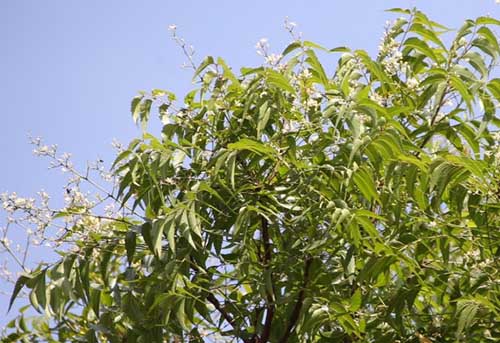
Musizi Umbrella Tree (Maesopsis eminii)
Self Help Africa Planting in Kenya
Musizi can reach up to 15-25(-45) m tall with an open crown and exceptionally straight trunk up to 50(-180) cm in diameter. Musizi is fast growing and productive and is often grown in plantations as an alternative to the slower growing pines and cypress, but the wood is not as durable and Musizi can become an invasive species in some areas.
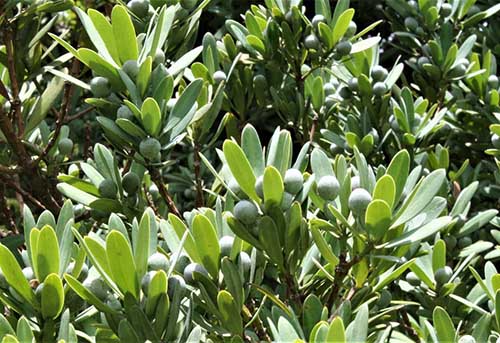
Podocarpus (Podocarpus latifolius, Podocarpus milanjianus)
Self Help Africa Planting in Kenya
Podocarpus is an ancient group of conifers (pines), related to Yews and, like most conifers, it is evergreen. Podocarpus is mainly found on the temperate mountains of Africa: Mt Mulanje in Malawi is famous for the Mulanje Podocarpus. It grows slowly up to 30 meters in height. A chemotherapy drug used in treatment of leukaemia is extracted from Podocarpus.
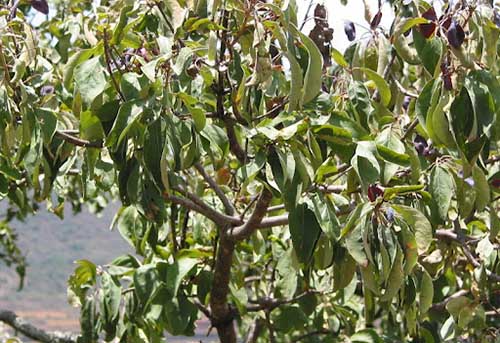
Terminalia Brownii
Self Help Africa planting in Kenya
Terminalia is a large family of trees with over 100 species, including the commonly known ‘Umbrella Tree’, Terminalia superb. They get their name from the Latin word ‘terminus’ which refers to the fact that the leaves appear at the very tips of the shoots. This is what gives it its unique umbrella shape. Several Terminalia sp. are fast growing soft woods that can be grown as an alternative to eucalyptus. Others are hard woods, with timber similar to oak and mahogany.
SHA plants indigenous Terminalia species browni, glaucescens, iverensis and mantaly for crop shade in coffee and banana and for restoring natural forests.
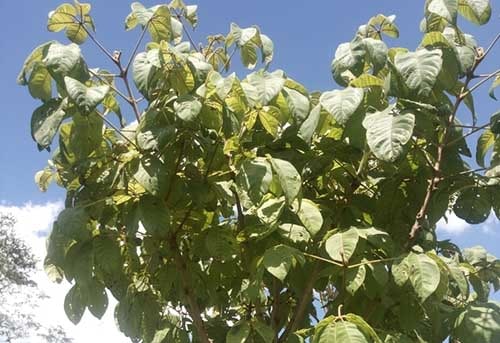
Meru oak (Vitex keniensis)
Self Help Africa Planting in Kenya
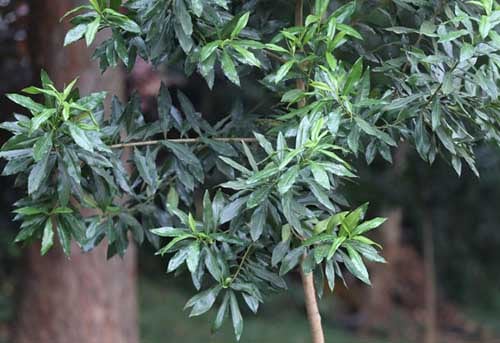
Ugandan greenheart (Warbugia Ugandensis)
Self Help Africa Planting in Kenya
Ugandan Greenheart is an evergreen tree native to Africa, found across East Africa. The wood is very strong and resistant to insect attack. The leaves are used to add flavour and spice when cooking food. The species can be planted for crop shade; and the fallen leaves and branches provide green manure and mulch for crop growing.
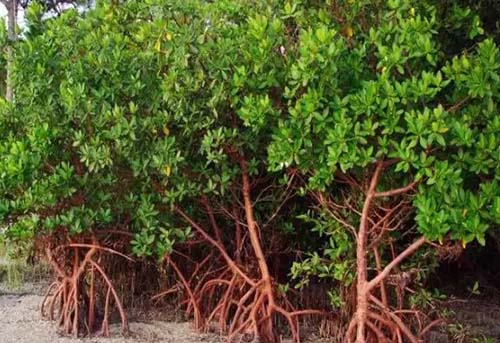
RED MANGROVE (RHIZOPHORA MANGLE)
Red mangrove is one of the most valuable trees for creating and preserving shorelines. Sediments depositing among their adventitious prop roots can eventually build up to create land. Seeds often germinate while they are still on the tree. After they drop, they float to a new location where they can begin growing in the sediment below the water surface.
It is a land reclamation plant.
Red mangroves will often be seen growing in shallow lagoons away from the land. Plants typically reach 6m tall, although old trees reach 22m tall are not uncommon in undisturbed, natural settings. Plants respond poorly to pruning.
Leaf color: dark to medium green on top, paler green underneath with tiny black dots that may require a hand lens to view
Bark: reddish brown and smooth, becoming gray and slightly fissured with age
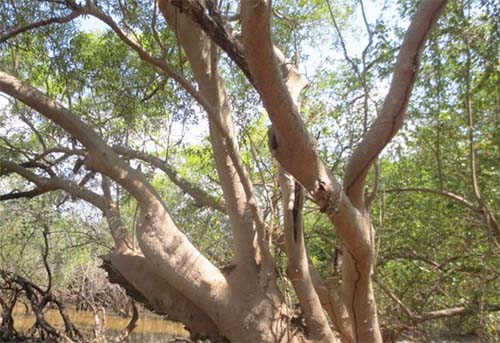
Avicennia 'Black Mangrove'
Self Help Africa planting in Senegal
Avicenna is a shrub or small tree in the acanthus family, Acanthaceae. Avicennia is found across the world, but in particular in intertidal estuaries along many of the world’s tropical and warm temperate coasts. The Black Mangrove has evergreen, simple, opposite, thick, leathery leaves that are oblong to elliptic in outline. The tree bark is narrow darker grey or blackish ridges and broader lighter brown furrows and grows to a height of 12 - 15m depending on location.
Like other mangrove species, the tree has adapted to live in saltwater areas, where other plants would not thrive. The leaves are silvery green - arising from their ability to take up saltwater, use the water and leave a salt residue on the leaves!
This amazing plant also has an unusual root system called pneumatophores or "air breathing roots" - the roots come up out of the sediment, and draw in air from overground! This allows the tree to get air - even though it's standing in sea water or mud.
Avicenna plays a vital role as a buffer between land and water. Mangroves help to prevent erosion, stabilize shorelines, and provide a habitat for a range of wildlife and marine organisms.
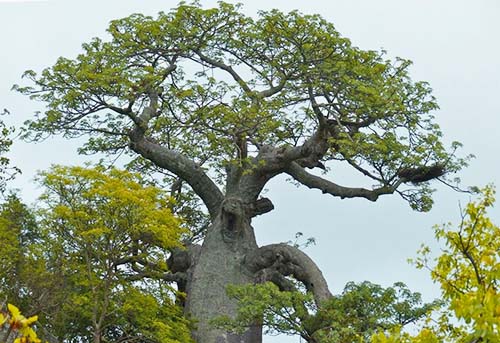
Adansonia Digitata (Baobab)
Self Help Africa planting in Senegal
Adansonia Digitata is commonly known as the Baobab tree.
The Baobab tree is native to the African continent - with many trees surviving and growing for hundreds of years. The African baobab is a massive deciduous fruit tree, growing up to 20-30m high. Its swollen and often hollow trunk looks like a huge bottle and can be as broad as 3-7m in diameter. It has an extensive lateral root system up to 50m away from the tree and rarely extend beyond 2 meter depth.
The baobab tree is of great importance to local people - providing a myriad of uses. The fruit pulp (rich in vitamin C) is eaten on its own or mixed in porridge and is also used for making soft drinks. Seeds are used as a thickener for soups, and leaves are eaten as a vegetable or in soups.
Fibres from the inner bark are used to make rope and string for basketry, as well as for making beehives. Roots, bark, leaves, fruits and seeds are used medicinally - for both human and veterinary treatments.
In Senegal, Baobab is being planted as part of reforestation project
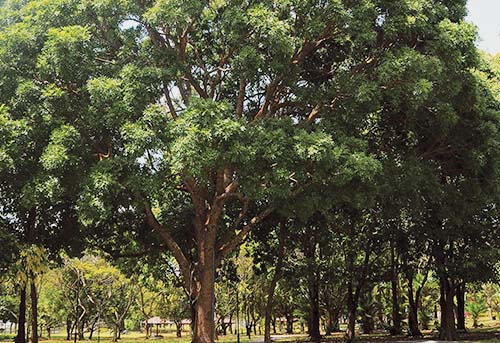
Kyaya senegalensis
Self Help Africa planting in Senegal
Native to West Africa, and sometimes called 'African mahogany' Khaya senegalensis is a deciduous evergreen tree, 15-30m high, up to 1m in diameter.
The tree typically grows in wetlands adjacent to rivers and streams; in higher-rainfall savannah woodlands; and in moist regions it is found on higher ground. During the 1st year, the seedling develops a strong, deep taproot, which makes it the most drought hardy of all the Khaya species.
The leaves and branches are used as fodder for animals, as well as in traditional medicine. The seeds have an oil content of 67% and are rich in oleic acid (66%). The oil is used in West Africa for cooking.
Because the timber from this species is valuable, the population has been declining steadily through over-harvesting.
In Senegal, Kyaya senegalensisis being planted as part of reforestation and regeneration projects
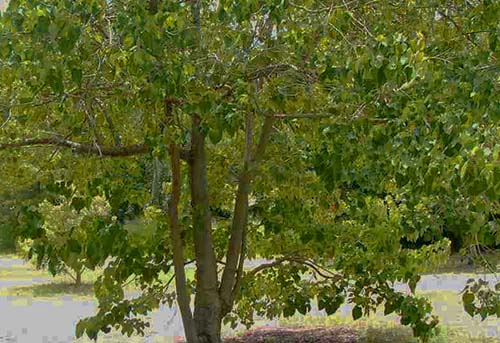
Gmelina arborea
Self Help Africa planting in Senegal
The Gmelina arborea is a large deciduous tree that can grow to heights 30m or more and have a diameter of up to 4-5m. It’s a very fast growing species, and suited to agro-forestry and for forest regeneration. This tree species prefers light more than shade and is often used for intercropping with cassava, cashew and maize.
After 18 months of growth, the tree’s low, dense canopy provides effective weed control
Animals use the branches and leaves for food and fodder; the fruit is also edible, and the flower nectar attracts bees and consequently are useful in honey production. The tree leaves, flowers, and bark are also used in traditional medicine.
G. arborea makes a very good fire break when planted at reduced spacing.
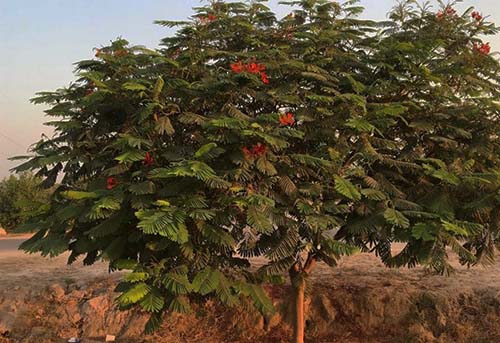
Delonix regia
Self Help Africa planting in Senegal
Known as 'the flame tree', most likely as a result of its large flame red flowers, the Delonix regia is a fast growing tree - and can reach heights of 15-18m tall. It has been cultivated over the years as an ornamental species, but in the wild, and in tree plantations and agroforestry the tree has many uses. Delonix is planted as a shade crop and can be used as 'live' fence posts. The trees are also planted in land regeneration projects to help with erosion control, soil rehabilitation; and nitrogen fixing.
D. regia starts flowering in its 4th or 5th years. The leaves, flowers, seed and bark of this plant contain a range of medicinally active compounds and is used in traditional medicine to treat a variety of ailments.
The species originates from Madagascar, where unfortunately it is now almost extinct. However, it is widespread in most tropical and subtropical areas of the world. The tree is a 'light demander' and grows poorly under shade; and it grows in areas with both high and scanty rainfall.
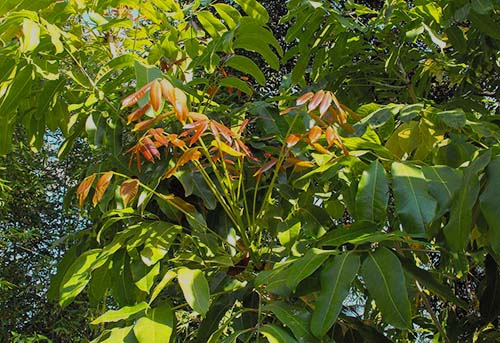
Khaya nyasica
Also known as red or white mahogany, this species is a large, fast growing semi deciduous tree; Trees can easily be propagated from seedlings, stumps and wildings and can often reach heights of 60m! The base of the tree may often be branch-less for the first 20m, before branching into a very large crown. The tree produces fragrant white flowers and it grows well in deep fertile soils, and can withstand seasonal flooding.
Unfortunately, this species has been heavily exploited for its valuable timber. As such it is now classed as a vulnerable species.
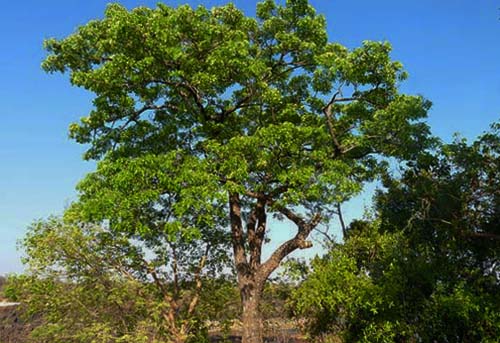
Afzelia quanzensis
Self Help Africa Planting in Malawi
Also known as Pod Mahogany, or 'Msamba mfumu' locally - this is a medium sized deciduous tree; with deep roots that typically grows to a height of 35m. The tree grows in many parts of Southern and East Africa usually in areas of low altitude woodland and dry forests, usually in deep sand. It produces sweet smelling flowers that attract many insects and pollinators.
The tree has been exploited for its valuable wood, and is also used locally for traditional medicine purposes.
Self Help Africa is planting to help restore the population of this species; and to provide shade. In addition the flower nectar attracts bees and consequently these trees are useful in honey production.
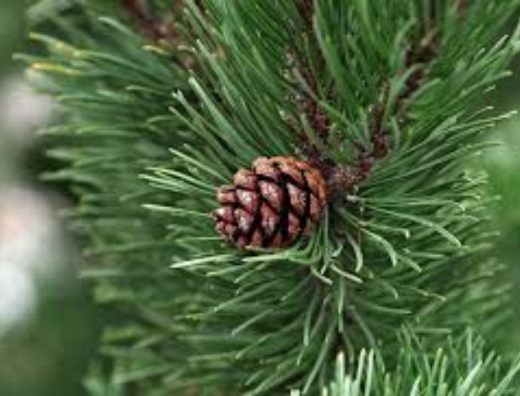
Pinus spp
Self Help Africa planting in several African countries
Pinus spp. (pine) trees are evergreen, coniferous resinous trees (or, rarely, shrubs) growing 3–80 metres tall, with the majority of species reaching 15–45 m tall. Pines may be found in a very large variety of environments, ranging from semi-arid desert to rainforests, from sea level up to 5,200 m, from the coldest to the hottest environments on earth. They often occur in mountainous areas with favorable soils and at least some water.
These trees are planted and growing in a wide range of forest and savanna habitats, scattered in fire-prone grassland and woodland, and plantations.
Pine trees are beneficial to the environment since they can remove carbon dioxide from the atmosphere. Pine pollen may play an important role in the functioning of detrital food webs. Nutrients from pollen aid detritivores in development, growth, and maturation, and may enable fungi to decompose nutritionally scarce litter. Pine needles are food to mesofauna to microfauna.
Fruit Trees
Self Help Africa Planting in Ethiopia, Kenya, Malawi, Zambia, Uganda, West Africa
Where Self Help Africa is working with farming families to have better nutrition in the home, planting suitable fruit trees, alongside small livestock, vegetables and pulses is critical to success. Fruit trees plantings for backyard gardens, for consumption at home, as well as orchards to grow fruit to sell and improve family income, happens across all SHA programme countries. Fruit trees commonly planted by Self Help Africa farmers include:
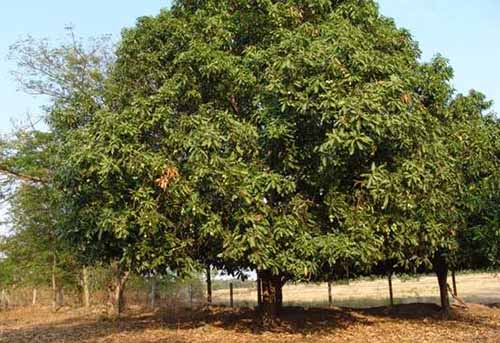
Mango
Mango trees can grow to a great size and the deep taproot enables them to survive the longest droughts.
As well as working with farmers to plant mangoes to eat at home, and sell, Self Help Arica promotes grafted mangoes where the production from old mango trees can often be improved by grafting buds from more productive varieties onto the trees. Old trees can also be made more productive through careful pruning.
There are over 500 varieties of mango, with each community preferring different local varieties, however the improved variety 'Tommy Atkins', has become very popular due to its excellent productivity and disease resistance, shelf life, transportability, size, and appealing colour. Alphonso and Kent are also popular commercial varieties.
In Northern Uganda mango trees bear fruit during the 'hunger gap' season and were planted alongside roads to provide 'famine food'.
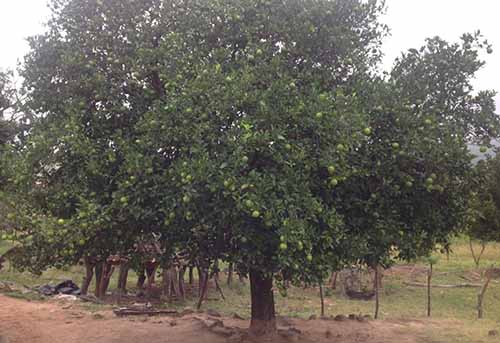
Guava
Guava is a common tropical fruit and is planted in gardens and backyards in SHA projects. Guava is an often-overlooked fruit but it is incredibly rich in vitamin C, with a single guava fruit providing 257% of the Daily Intake of vitamin C!
Anyone who has tried to grow guava trees will know how attractive the fruit are to children – no persuasion needed to get children to eat guavas!
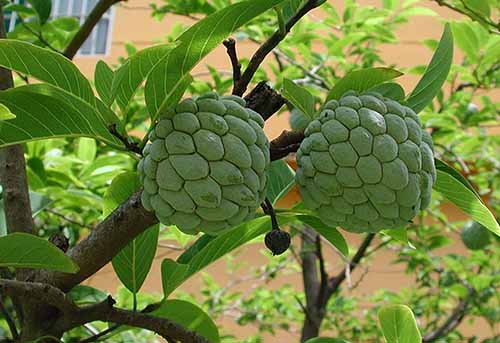
Custard apple (Annona squamosa) / Soursop
The custard apple is sweet and creamy, and the soursop is sharp and refreshing.
Custard Apples and Soursops are grown throughout the tropics and subtropics, and the small trees, reaching a height of 3 - 6 metres, are planted by SHA in gardens and backyards.
Unfortunately they do not store well so its very rare that these delicious fruits ever reach the shelves of Irish or UK supermarkets.
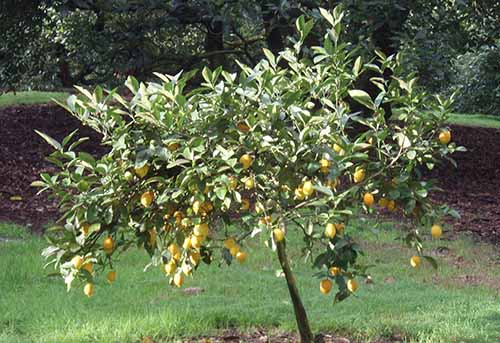
Lemon
The lemon tree is one of the most common citrus trees that can be grown. They range from 6 to 8 metres tall and have long twiggy branches covered in thorns. The flowers produced are very fragrant, and when they open the petals are white on the outside and purple underneath.
The fruit of the lemon tree is its common identifier, where an oval shaped fruit is bright yellow in colour. The fruit is aromatic and is a very common flavour across the world. Lemons are an outstanding source of vitamin C, and as such families are encouraged to grow lemons as part of their backyard garden, to eat at home, as well as for sale at market.
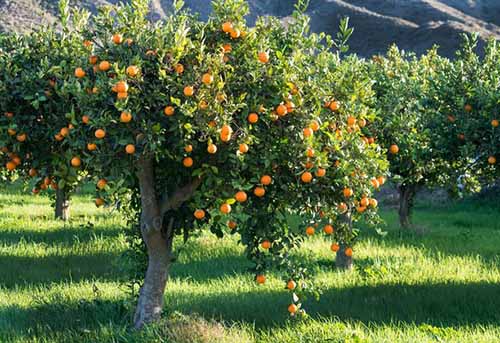
Orange
There are many varieties of orange but the most common grown varieties amongst farmers that Self Help Africa works with are the Valencia and Washington Navel variety. Oranges are rich in nutrients, including vitamin C.
Depending on the climate, this tree can offer ripe citrus fruits within 8 months, however even when ripe the oranges grown in sub-Saharan Africa are often green!
To develop an orange colour the fruits need more than 12 hours of sunlight per day – but near the Equator they only receive 12 hours of light.
To help the trees withstand droughts, termites and disease oranges are grafted onto Rough Lemon rootstocks.

Papaya
Carica papaya is a small tree that produces a large berry fruit, more commonly known as papaya. This tree produces flowers that are sweet scented and only open at night. The papaya fruit is ripe when its soft to touch and attains an amber orange hue. The fruit is usually eaten raw, however if the fruit is not ripe it can still be enjoyed once cooked and is common in salads and stews.
Papaya is an ideal backyard tree – to provide fruit consumed at home. Papaya is a good source of vitamin A, an essential nutrient, needed to help the body's immune system work properly.
Papaya produces a white latex that contains an enzyme, papain - used in the meat processing industry as it helps to tenderise meat. Traditionally, a poultice of raw green papaya is used to help remove thorns and splinters from the skin and its is traditional belief that swallowing a few of the bitter tasting seeds when eating papaya for breakfast will help avoid intestinal worms!
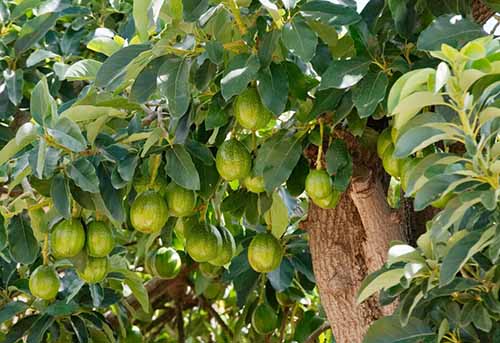
Avocado
The avocado, which has become very popular, is the fruit of the Persea americana tree. This delicious fruit is botanically a large berry containing a single large seed.
Self Help Africa nutrition advisors promote growing avocados at home to improve household nutrition. The fruit is a rich source of oils and is an excellent weaning food. The nut also contains oils, used in the cosmetics industry, which can be extracted with small scale processing equipment.
Avocado needs a warm wet climate with little wind, but grows readily from discarded seeds, and is found growing wild on roadsides in the wetter areas of Uganda and Kenya. Avocado is a self-pollinator: ‘Hass’ is the most common male cultivar, and the preferred export variety, and ‘Feurte’ is the most common female cultivar.
Mature avocado trees can grow quite large and Self Help Africa is supporting farmers to grow dwarf Avocado trees which require less space, and the fruits can be harvested easier. Despite huge demand for avocados in the international market small-scale farmers require support and assistance in organising the marketing of their avocados. Self Help Africa works with farmers to find markets and get fair prices for their produce.
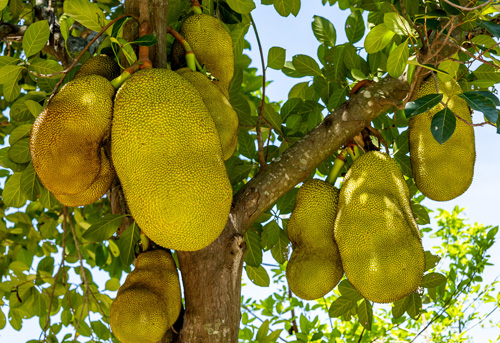
Jackfruit
The Jackfruit grows to 20m in height with a large trunk and dense treetop. The bark is reddish brown in colour and if it is damaged it produces a milky juice.
Jackfruit bears the largest fruit of all trees reaching as heavy as 55kg. One tree can bear up to 300 fruits per year, and 500 if it’s a mature tree – That’s one heavy tree! The fruits are too heavy for small branches and grow on the trunk and larger branches. The fruits ripen from July to August. Jackfruits have a very strong smell – avoid storing Jackfruit into your house! The taste varies, from incredibly sweet, and for some too sweet, to bland and the unripe fruit can be cooked as a meat substitute for vegetarians.
Self Help Africa promotes jackfruit planting for backyard gardens, where it provides shade and one tree produces more than enough fruit to feed a family.

Citrus Sinensus
Self Help Africa planting in most African countries
Citrus sinensis (dwarf orange) is a small, shallow-rooted evergreen shrub or tree about 6-13 m high with an enclosed conical top and mostly spiny branches. Twigs angled when young, often with thick spines
It is mostly grown for its fruits that are sold to earn income; the fruits are a good source of vitamin C; pulp, molasses, and residues from juice production are used as cattle feed; flowers are a source of nectar; its wood is a potential source of wood fuel; peels, leaves, and flowers contain fine essences of oils that may be used in manufacture of cosmetics and medicinal applications; extracts from leaves, roots, bark, and fruit extracts have medicinal value; and it provides shade and ornamental benefits.
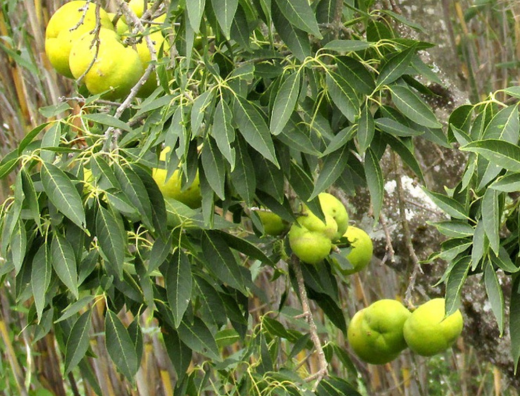
Casimiroa edulis
Casimiroa edulis (white sapote, white zapote, Mexican apple, Mexican sapote, casimiroa) originated from the highlands of Mexico and Central America now widely grown in the tropics. It is fairly drought resistant. It is an is an evergreen tree to 18 m tall, with spreading, often drooping branches and a broad leafy crown. Bark light-grey, thick and warty.
White sapotes are commonly grown from seeds and seedlings usually begin to bear fruit in 7-8 years. They occur both cultivated and wild and hence they can be propagated through assisted natural regeneration (ANR). Seed kernel extracts are poisonous/lethal bait for cockroaches; the fruit is eaten as dessert and the flavour is sweet with a hint or more of bitterness and sometimes distinctly resinous. Its wood is yellow, fine-grained, compact, moderately dense and heavy, medium strong and resistant, but not durable for long. This tree is planted as shade for plantations such as coffee. Extracts from the leaves, bark, and especially the seeds have been employed in the medicine industry as sedatives, soporifics and tranquilizers.
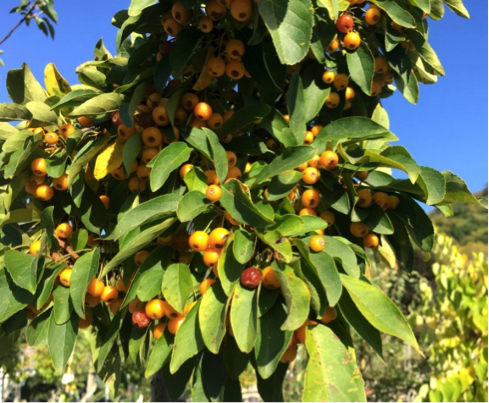
Malus Cinzam
The genus Malus is native to the temperate zone of the Northern Hemisphere
Malus cinzam (cinderella crabapple) a dwarf, compact tree that has the form of a 'lollipop' tree. It'll grow to about 8 feet tall and 5 feet wide and is low maintenance. In early spring, new growth emerges bright green and is covered in red flower buds that open to pure white, fragrant flowers.
Crabapples are ornamentals that are closely related to common apple trees and are distinguished by fruit size. Technically, any apple fruit that is smaller than 2-inches is a crabapple. There are approximately 1,000 different varieties of crabapples, with about 100 of these being commonly planted. Crabapples are an excellent addition to Utah landscapes as they are drought tolerant, low maintenance, and versatile trees. They withstand low winter temperatures and the hot dry conditions.
They are an excellent addition to the landscape where space is limited, such as under power lines. Trees bloom profusely in the spring and flowers can be fragrant, making them a better selection for the landscape than flowering plums. Fall foliage is bright and colorful and is often followed by brightly colored fruits that provide a food source for birds in late fall and early winter.
Irish Trees
In Ireland we are working with our partners, Trees on the Land, to plant native Irish Trees in different sites around Ireland. Planting in Ireland takes place from late Autumn through to the Spring, usually October – April.
Trees on the Land work with farmers, community groups, councils and other landowners to find land to accommodate trees each season, and plant individual trees, groups of trees, small woodlands, shelter belts, hedgerows, coppice groves, orchards and in larger woodlands.
Trees on the Land have supplied bare-rooted forestry grade whips for planting - these young trees are hardy and well adapted to the Irish climate and being small, can be handled and planted easily.
A number of common native Irish trees have been planted, including:
OAK / Dair ghaelach (Quercus petraea)
BIRCH / Beith (Betula pubescens / pendula)
ALDER / Fearnóg (Alnus glutinosa)
ROWAN / Caorthann (Sorbus aucuparia)
HAWTHORN / Sceach gheal (Crataegus monogyna)
HAZEL / Coll (Corylus avellana)
CRAB APPLE / Crann fia-úll (Malus sylvestris)
These trees serve well for establishing woodlands, copses, hedgerows and shelter belts in all sorts of conditions
Find out more about Self Help Africa's work on climate change
Self Help Africa works to help protect smallholder farmers in rural Africa to help fight against the worst effects of climate change.
View info on our other work in tree planting and climate change.
View other stories relating to our work in Africa.
View our campaign FAQ.

